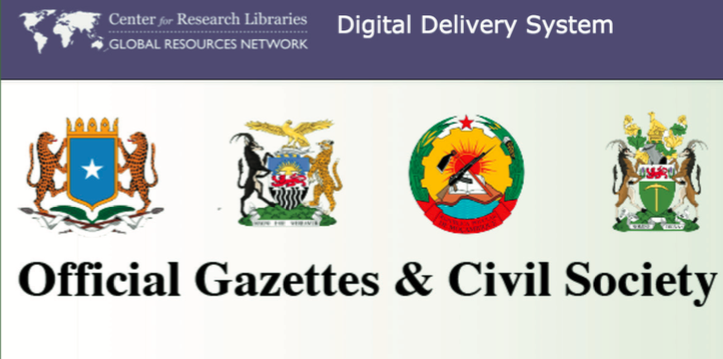In 2014 the Carnegie Corporation of New York awarded the Center for Research Libraries (CRL) funding to preserve and make available on the open web endangered government documentation from several African and Persian Gulf region nations. The $248,500 grant enabled the digitization of official gazettes that have been preserved over the past 60 years by CRL and its partner institutions.

Government publications known as official gazettes (variously titled “journal officiel,” “diario oficial,” “bulletin officiel”) have long been key documents of civil society. These publications function as the legal newspapers of many countries, wherein the texts of new laws, decrees, regulations, international treaties, legal notices, legislative debates, and court decisions are announced. The laws published in the gazettes are the versions of record—and in many jurisdictions the only published versions—of many nations’ primary laws. In some cases, publication in the gazette even initiates jurisdiction.
Despite their fundamental significance, gazettes in countries with repressive or authoritarian regimes are not often widely accessible to the public. Various indices such as the Economist Intelligence Unit’s Democracy Index and the World Justice Project Rule of Law Index measure government transparency and accessibility to information. The focus of the CRL project was to digitize and post on the web official gazettes published in ten nations cited in Transparency International’s Corruption Perceptions Index as among the countries with the most corrupt public sectors.1
Targeted countries and publication dates included:
| Algeria | 1945–2016 |
| Congo (Republic) | 1958–2016 |
| Iran | 1970–1994 |
| Iraq | 1958–2016 |
| Libya | 1951–2014 |
| Morocco | 1956–2016 |
| Mozambique | 1975–1988; 2006–2016 |
| Nigeria* | 1958–1974 |
| Somalia | 1960–1989 |
| Sudan | 1899–1986 |
| Zimbabwe | 1980–1997; 2003–2014 |
| *While Nigeria was not among the originally targeted countries, CRL was able to include Nigerian gazettes from 1958–1974 as a result of cost savings in its digital operations. | |
CRL’s effort focused on countries where content was inaccessible or might be at risk of loss due to unstable governments or questionable infrastructure. CRL worked with subject specialists in Middle East and African studies to identify relevant gazettes and available holdings. To ensure a more comprehensive collection of resources, CRL digitized materials from partner libraries as well as its own holdings. Content partners included:
- Columbia University
- Library of Congress
- Los Angeles County Law Library
- New York Public Library
- Princeton University
- University of Chicago
CRL significantly exceeded its projected targets of pages digitized from print and microfilm by leveraging production efficiencies. Through its partnership with the Law Library Microform Consortium (LLMC), CRL was able to scan nearly 80,000 pages of content from print sources. Likewise, CRL’s provider of document conversion services was able to scan nearly 544,000 pages from microfilm. In total, the project yielded 623,430 pages from print and film sources.
To augment the print and microfilm collections held by libraries, CRL also investigated the extent of published gazettes online on current government websites. Harvesting digital content from web sources (government sites or other academic programs) added 597,000 pages to the open web repository. In total, CRL’s efforts resulted in 1,220,456 pages—more than 40,000 issues—of key historical documentation made available together online for the first time.
CRL’s Official Gazettes & Civil Society Documentation digital collection became publicly available in June 2016.
CRL’s efforts to make legal documentation from the selected countries openly accessible online will ensure unrestricted, long-term access to documentation that defines the rights and obligations of citizens in those countries. Many of the materials will now be freely available to populations in the regions of origin and to scholars from those regions. The availability of CRL’s open web repository will also promote those governments’ accountability by providing a permanent “offshore” public record, immune to revision or alteration over time by hostile regimes and factions.
- The Corruption Perceptions Index scores and ranks countries/territories based on how corrupt a country’s public sector is perceived to be. The CPI is an indicator of perceptions of public sector corruption, not a verdict on the levels of corruption of entire nations or societies, or of their policies, or the activities of their private sector. (Corruption Perceptions Index 2015: Frequently Asked Questions).